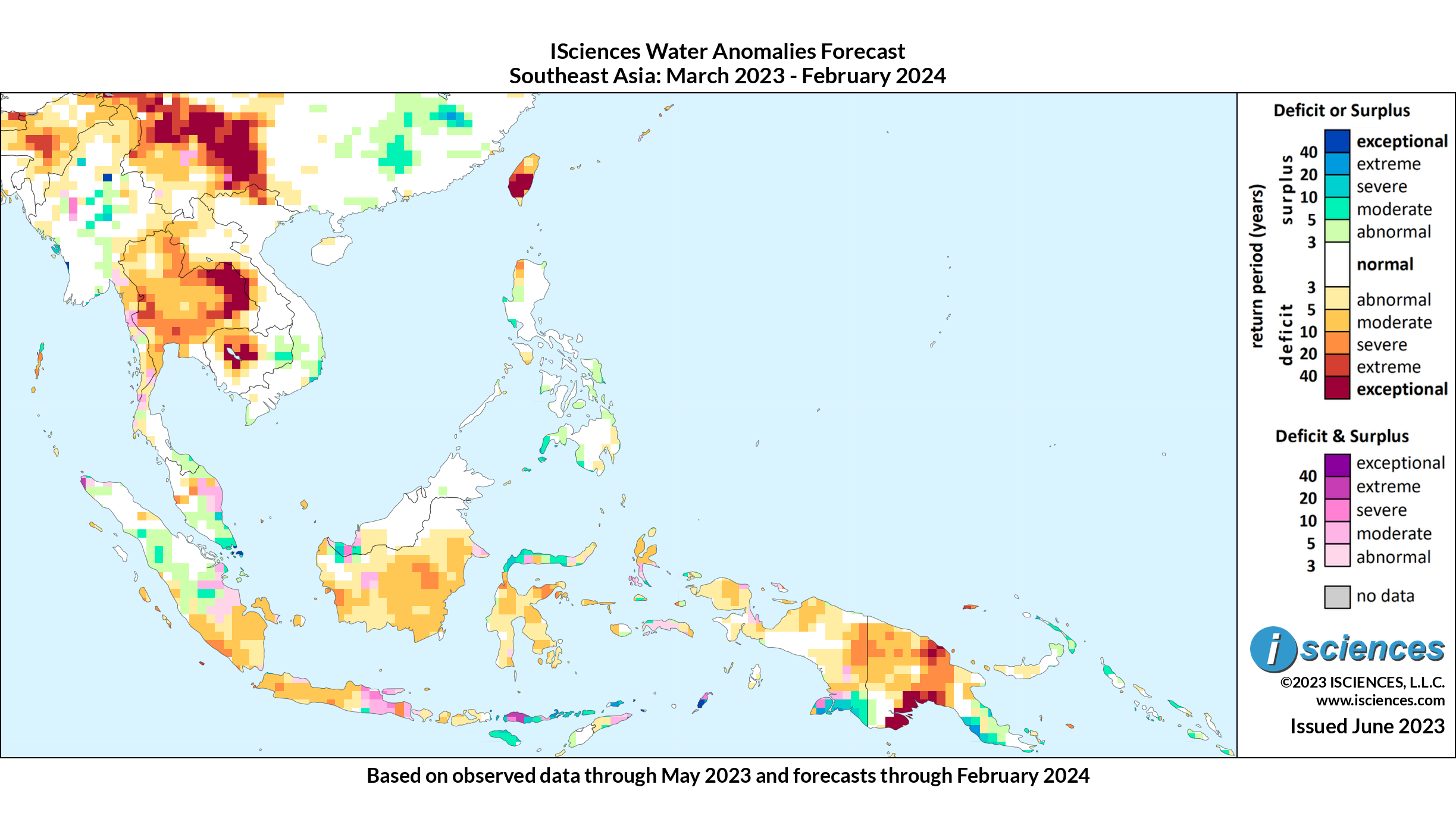Southeast Asia & the Pacific: Widespread deficits to persist throughout
30 June 2023
THE BIG PICTURE
The 12-month forecast ending in February anticipates widespread deficits throughout much of Mainland Southeast Asia, with mixtures of moderate deficits and surplus also appearing across most Indonesian islands.
Extreme to exceptional deficits are expected in:
Eastern Thailand, throughout the provinces of Nakhon Phanom, Mukdahan, Bueng Kan, and Sakon Nakhon.
Central Cambodia, appearing in surrounding areas of the Tonlé Sap.
Indonesia, appearing in southern Sumatra, western Java, throughout Kalimantan, North Maluku, and central to southern Sulawesi.
East-central Papua, in the Pegunungan Bintang Regency.
Southern coastal regions of Papua New Guinea along the Coral Sea, as well as in the northeastern city of Madang.
Moderate to severe surplus is anticipated in the following areas:
Indonesia, appearing in northern Sumatra, northern Sulawesi, and the Lesser Sunda Islands.
Throughout most of Singapore.
Southern Papua, spread through much of the Merauke Regency.
Southeastern Papua New Guinea, near Port Moresby.
The 3-month maps (below) show the evolving conditions in more detail.
FORECAST BREAKDOWN
The forecast through August 2023 indicates that much of the region’s intense deficit anomalies will subside, becoming mostly mild to moderate. Some areas will experience continued exceptional deficits, such as Cambodian regions southwest of Tonle Sap, and coastal regions of Papua New Guinea. Various islands of Indonesia can also expect persistent deficits, such as southern Sumatra, western Java, and much of Kalimantan. Exceptional surplus is expected in the Lesser Sunda Islands, southern Papua and Papua New Guinea, the Philippines, and central Vietnam.
From September through November 2023, moderate to severe deficits are expected to be widespread throughout most of Maritime Southeast Asia, with the most intense anomalies appearing in northern Sulawesi, eastern Kalimantan, Java, southern Sumatra, and throughout Papua and Papua New Guinea. Much of Mainland Southeast Asia can expect normal conditions, except western Malaysia, which can expect moderate to severe deficits around the state of Perak.
The forecast for the final months – December 2023 through February 2024 – expects some moderate deficits in islands of Indonesia to subside, with mild to moderate surplus appearing throughout Sumatra, as well as mainland Malaysia and the island of Borneo. Widespread moderate to severe deficits are still expected in Papua, Papua New Guinea, Java, Sulawesi, and the Philippines.
Please note that WSIM forecast skill declines with longer lead times.
IMPACTS
Thailand’s Joint Standing Committee on Commerce, Industry and Banking (JSCCIB) anticipates that economical damages from drought, floods, and other extreme weather events could potentially cost the equivalent of one billion USD this year. Kriengkrai Thiennukul, chairman of the Federation of Thai Industries (FTI), claimed water scarcity caused by drought could have a major impact on the country’s already hindered agricultural and manufacturing sectors. According to the Commerce Ministry's latest data, Thai exports decreased by 5.2 percent year-on-year to 92 billion USD in January to April 2023, while imports fell by 2.2% to 96.5 billion USD, resulting in a trade deficit of 4.51 billion USD. Thailand’s Meteorological Department predicts that this year’s total rainfall will be around 5% below the annual average. The El Niño phenomenon is expected to continue until February 2024, with its peak anticipated in August and September.
Cambodian agriculture officials recently warned farmers of an impending drought across the country. Yang Saing Koma, secretary of state at the Ministry of Agriculture, Forestry and Fisheries, has issued a reminder to farmers to appropriately prepare for an upcoming brief period of drought. He cited a forecast by the Ministry of Water Resources and Meteorology, stating that drought conditions are predicted to occur from early July to early August. “I urge farmers to take preventive measures to mitigate the impacts of a brief drought by storing rainwater in canals and ponds during the rainy season,” he said.
The Indonesian government has started to practice genetic engineering in order to maintain their self-sufficiency target for corn production in 2024. The Ministry of Agriculture noted that Indonesia has 10 genetically engineered seed products that have been registered, namely eight varieties of corn, one variety of sugarcane, and one variety of potato. "Genetic engineering can make the impossible possible, such as obtaining corn plants that are resistant to stem borer," a biotechnology researcher from the National Research and Innovation Agency (BRIN), Happyawati Amirhusin, remarked. The emergence of genetically engineered crops is able to provide economic benefits to farmers, as plants will become more resilient to changes in temperature and environment, as well as increase the quantity and quality of crop yields.
NOTE ON ADMINISTRATIVE BOUNDARIES
There are numerous regions around the world where country borders are contested. ISciences depicts country boundaries on these maps solely to provide some geographic context. The boundaries are nominal, not legal, descriptions of each entity. The use of these boundaries does not imply any judgement on the legal status of any territory, or any endorsement or acceptance of disputed boundaries on the part of ISciences or our data providers.
Subscribe to our monthly Water Watch List
Search blog categories
- *Precip/Temp Outlooks 101
- *Press Releases 1
- *Special Topics 19
- *Water Watch Lists 119
- Africa 129
- Australia & New Zealand 113
- Canada 115
- Central Asia & Russia 113
- East Asia 114
- Europe 120
- Mexico & C. Amer. & Carib 118
- Middle East 123
- Proof Point 1
- South America 128
- South Asia 119
- Southeast Asia & Pacific 122
- United States 119
Search blog tags



